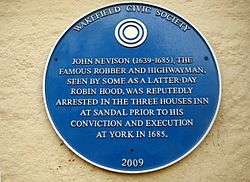John Nevison

John Nevison (1639 – 4 May 1684), also known as William Nevison, was one of Britain's most notorious highwaymen, a gentleman rogue supposedly nicknamed Swift Nick by King Charles II after a renowned 200-mile (320 km) dash from Kent to York to establish an alibi for a robbery he had committed earlier that day. The story inspired William Harrison Ainsworth to include a modified version in his novel Rookwood, in which he attributed the feat to Dick Turpin. There are suggestions that the feat was actually undertaken by one Samuel Nicks.
History
Nevison was born in 1639, probably in Wortley in present-day South Yorkshire. He ran away from home at the age of 13 or 14 and may have ended up in London. Forced to flee to Holland to evade the authorities he enrolled in the Duke of York's army and took part in the 1658 Battle of Dunkirk. After his discharge he returned to England and took care of his father for several years before adopting the same profession as many of his contemporary ex-soldiers, that of a highwayman. Basing himself around Newark, he targeted those travelling along the Great North Road between Huntingdon in the south and York to the north.[1]
In the mid-1670s his activities were under investigation and he was associated with men named Edmund Bracy, Thomas Wilbore, Thomas Tankerd, John Bromett, and William (or Robert) Everson and John Brace or Bracy, which may have been his alias. The robbers used safe houses at Tuxford and Wentbridge and divided their spoils at the Talbot Inn at Newark.[2] Nevison developed a reputation as a gentleman highwayman, never using violence against his victims, always polite, and only robbing the rich.[1]
The famous ride from Kent to York took place in 1676, after Nevison had robbed a traveller at Gad's Hill, near Rochester, Kent. Nevison escaped, using a ferry to cross the Thames and galloped via Chelmsford, Cambridge and Huntingdon to York some 200 miles (320 km) from the scene of the crime. He arrived at sunset and ensured he met the city's Lord Mayor, entering into a wager on a bowls match. When he was arrested and tried for the Gad's Hill robbery, he produced the Lord Mayor to support his alibi and was found not guilty.[3]
Nevison was tried and convicted for the theft of a horse and highway robbery at York assizes in 1677. He was imprisoned in York Castle but, on offering to inform against his accomplices was pardoned and was to be transported. In 1681 he was taken from gaol to be enlisted in a company of soldiers bound for Tangier but escaped. A reward was offered for his recapture.[2] He was arrested on 6 March 1684 at the Three Houses Inn in Sandal Magna near Wakefield and tried for the murder of Darcy Fletcher, a constable who had tried to arrest him near Howley Hall at Soothill in Batley.[2][4] He was taken to York where, because he had breached his pardon, was "told him he must dye, for he was a terrour to the country". Nevison was hanged at the Knavesmire in March 1684 and buried in an unmarked grave in St Mary's Church, Castlegate.[2]
References
Notes
- 1 2 John Nevison, Wakefield Council, archived from the original on 23 March 2014, retrieved 18 April 2013
- 1 2 3 4 Wales, Tim (2004), "Nevison [Nevinson], John [William] (d. 1684), highwayman", Oxford Dictionary of National Biography (online ed.), Oxford University Press, retrieved 12 April 2013 (subscription or UK public library membership required)
- ↑ John "Swift Nick" Nevison, stand and deliver.org, retrieved 12 April 2013
- ↑ Walker 1966, p. 460.
Bibliography
- Walker, J. W. (1966), Wakefield its History and People Vol.1&2 3rd Edn, S. R. Publishers
Further reading
- Fletcher, J. S. (1917) Memorials of a Yorkshire Parish facsimile published by Old Hall Press, Leeds 1993
- Padgett, Lorenzo (1905) Chronicles of Old Pontefract facsimile published by Old Hall Press, Leeds 1993